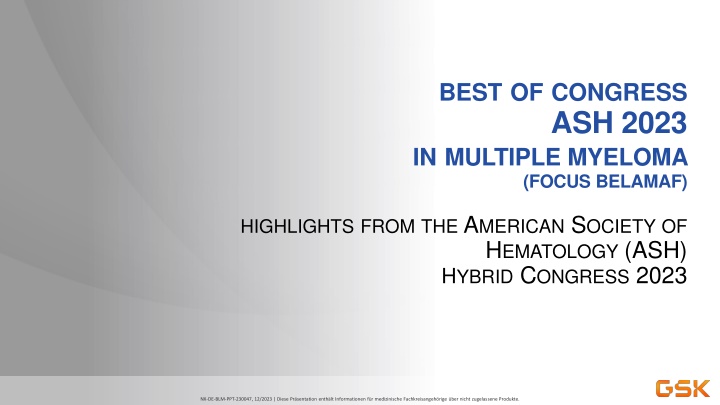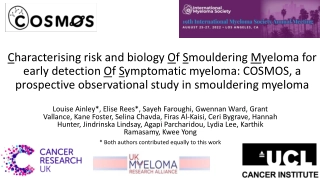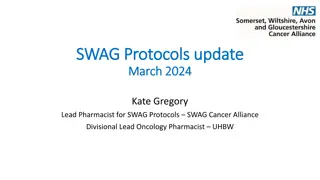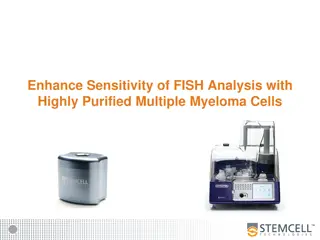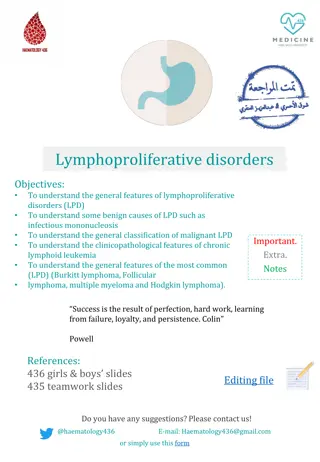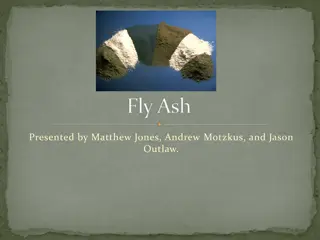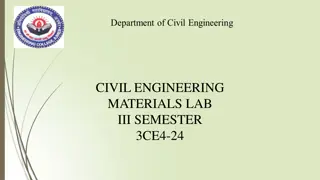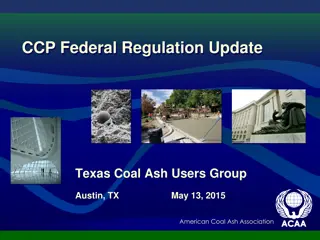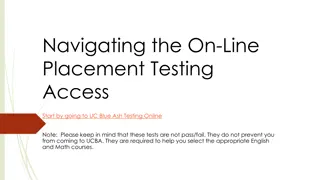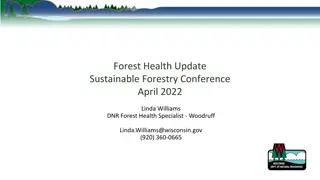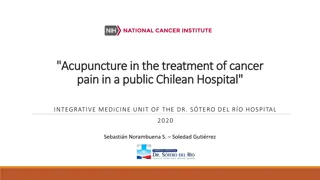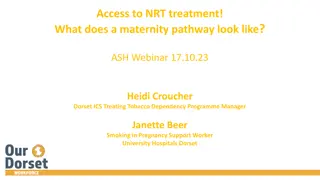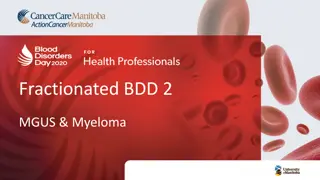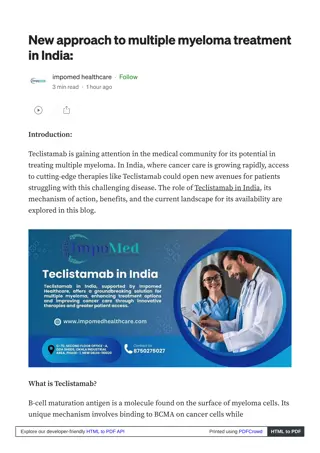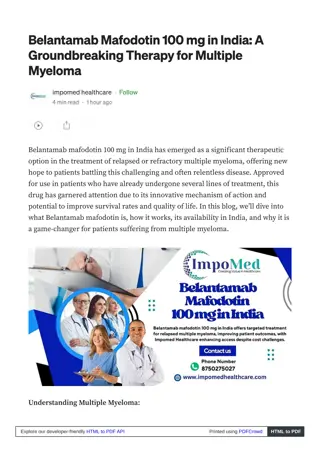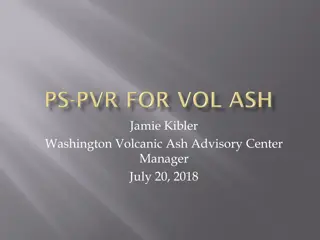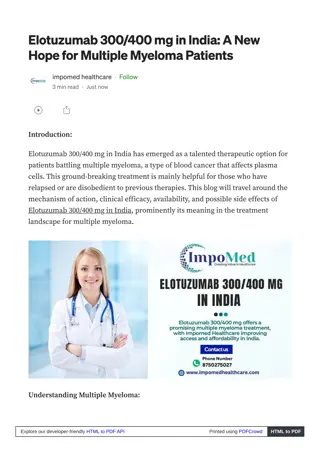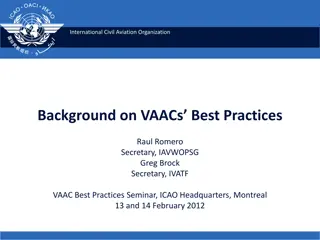Updates on Belamaf in Multiple Myeloma: ASH 2023 Highlights
Explore the latest findings from the American Society of Hematology (ASH) 2023 Hybrid Congress regarding Belamaf in multiple myeloma, including real-world outcomes, safety and efficacy analyses, long-term treatment impacts, infection risk, ocular toxicity prevention, and more. Key presentations cover a range of studies and trials showcasing the potential of Belantamab Mafodotin in different settings of relapsed or refractory multiple myeloma. Stay informed about advancements in the field of multiple myeloma treatment and care.
Download Presentation

Please find below an Image/Link to download the presentation.
The content on the website is provided AS IS for your information and personal use only. It may not be sold, licensed, or shared on other websites without obtaining consent from the author.If you encounter any issues during the download, it is possible that the publisher has removed the file from their server.
You are allowed to download the files provided on this website for personal or commercial use, subject to the condition that they are used lawfully. All files are the property of their respective owners.
The content on the website is provided AS IS for your information and personal use only. It may not be sold, licensed, or shared on other websites without obtaining consent from the author.
E N D
Presentation Transcript
BEST OF CONGRESS ASH 2023 IN MULTIPLE MYELOMA (FOCUS BELAMAF) HIGHLIGHTS FROM THE AMERICAN SOCIETY OF HEMATOLOGY (ASH) HYBRID CONGRESS 2023 NX-DE-BLM-PPT-230047, 12/2023 | Diese Pr sentation enth lt Informationen f r medizinische Fachkreisangeh rige ber nicht zugelassene Produkte.
HINWEISE Bitte beachten Sie Dieser Foliensatz wurde von der GlaxoSmithKline GmbH & Co. KG mit gro er Sorgfalt erstellt, um Fachkreisangeh rigen ausgewogene Informationen ber GSK Produkte und/oder Anwendungsgebiete zur Verf gung zu stellen. Wir weisen darauf hin, dass sich wissenschaftliche Informationen kontinuierlich ndern k nnen und der vorliegende Foliensatz eine Momentaufnahme zum Zeitpunkt der Erstellung abbildet. Bitte ber cksichtigen Sie dies bei der Betrachtung des Foliensatzes. Diese Folien dienen ausschlie lich der Verwendung im Scientific Engagement und zur Diskussion durch die Mitglieder des medizinischen Fachbereichs (z.B. MSLs) mit HCPs. Stand der Information: 12/2023 Herausgeberin: GlaxoSmithKline GmbH & Co. KG Prinzregentenplatz 9 81675 M nchen NX-DE-BLM-PPT-230047, 12/2023 | Diese Pr sentation enth lt Informationen f r medizinische Fachkreisangeh rige ber nicht zugelassene Produkte.
MULTIPLE MYELOMA Overview of ASH 2023 Belamaf presentations Real-World Outcomes of Medicare Fee-for-Service Beneficiaries Meeting the Eligibility Criteria for the DREAMM-7 and DREAMM-8 Clinical Trials (Simon McNamara, ASH 2023, Abstract 1965) Belantamab Mafodotin in Combination with Lenalidomide Plus Dexamethasone in Patients with Relapsed/Refractory Multiple Myeloma: Safety and Efficacy Analysis of DREAMM-6 Trial Arm-A (Rakesh Popat, ASH 2023, Abstract 2010) A Phase I/II Single Arm Study of Belantamab Mafodotin, Carfilzomib and Dexamethasone in Patients with Relapsed Multiple Myeloma: Planned Interim Analysis of Safety and Efficacy. Amarc 19-02 Belacard Study (Masa Lasica, ASH 2023, Abstract 2012) Impact of Long-Term Treatment with Belantamab Mafodotin on Safety and Efficacy Outcomes in Patients with Relapsed/Refractory Multiple Myeloma in DREAMM-3 (Vania T.M. Hungria, ASH 2023, Abstract 3357) Infection Risk and Use of Prophylaxis with Anti-BCMA Bispecific T Cell Engagers and Belantamab Mafodotin for Patients with Relapsed and Refractory Multiple Myeloma (Rakesh Popat, ASH 2023, Abstract 4702) Prevention of Ocular Toxicity Using Protective Contact Lenses in Multiple Myeloma Patients Receiving Belantamab Mafodotin, Pomalidomide and Dexamethasone: A Sub-Study of the Cmrg-007 Trial (Martha L. Louzada, ASH 2023, Abstract 4756) Long-Term Safety and Efficacy Results of Belantamab Mafodotin Plus Lenalidomide and Dexamethasone in Transplant Ineligible Patients with Newly Diagnosed Multiple Myeloma: An Updated Part 1 Analysis from the Phase 1/2 Belard Trial (Evangelos Terpos, ASH 2023, Abstract 4765) Efficacy and Safety of Belantamab Mafodotin Monotherapy in Patients with Relapsed or Refractory Light Chain Amyloidosis: A Phase 2 Study By the European Myeloma Network (Efstathios Kastritis, ASH 2023, Abstract 4779) NX-DE-BLM-PPT-230047, 12/2023 | Diese Pr sentation enth lt Informationen f r medizinische Fachkreisangeh rige ber nicht zugelassene Produkte.
Real-World Outcomes of Medicare Fee-for-Service Beneficiaries Meeting the Eligibility Criteria for the DREAMM-7 and DREAMM-8 Clinical Trials Simon McNamara et al., ASH 2023 abstract 1965 Study aim To provide real-world (RW) context for the DREAMM-7 and DREAMM-8 Phase III randomized controlled trials (RCTs), by reporting updated treatment patterns and patient outcomes in Medicare Fee-for-Service (FFS) patients with characteristics1 that approximate the inclusion/exclusion criteria for each trial. Conclusions RW outcomes in the DREAMM-7 and DREAMM-8 cohorts of Medicare FFS patients with relapsed/refractory multiple myeloma (RRMM) were suboptimal: ~ 50% of patients died within 3 years of entry into their cohort, and median time to next treatment or death (TTNTD) was ~15 months in both cohorts. Lenalidomide with/without steroids and bortezomib with/without steroids were the most common treatments in each cohort. Retreatment with lenalidomide was common in cohort 2 (DREAMM-8). These RW results demonstrate a substantial need for new effective treatment modalities to improve patient outcomes and provide further treatment choice in the 2L+ RRMM setting. 2L+, second line of therapy or beyond. 1. Tkacz J. Clin Lymphoma Myeloma Leuk. 2022;22(S2):S423. Abstract NX-DE-BLM-PPT-230047, 12/2023 | Diese Pr sentation enth lt Informationen f r medizinische Fachkreisangeh rige ber nicht zugelassene Produkte.
Study Design & Patients Measurement window Treatment index-finding period 12-month baseline Follow-up period Measures Treatment patterns All cause healthcare utilization and cost MM-related healthcare utilization and cost Overall survival Measures Clinical characteristics including NCI score and select comorbidities Healthcare utilization and cost measures Demographics Assessed on index 6-month MM naive period Treatment index date (2L or 3L initiation) Jan-1-2012 Jan-1-2016 Dec-31-2019 Dec-31-2021 Diagnostic index date Patient characteristics Cohort 1 N=1,108 Cohort 2 N=939 Inclusion and exclusion criteria for Cohort 1 and Cohort 2 Based on the approximations of inclusion/exclusion criteria from each RCT protocol, the following criteria were used to identify patients for this RW study who would be eligible for RCT enrollment: Patients in Cohorts 1 and 2 had a MM diagnosis (based on an ICD-9-CM or ICD-10-CM diagnosis code) and 1 prior line of therapy. Patients in Cohort 2 also had prior lenalidomide treatment for 2 consecutive cycles. Exclusion criteria included another cancer diagnosis, participation in a clinical trial during the study period, medical conditions related to renal, liver, and cardiovascular function, and: Cohort 1: refractory to daratumumab, bortezomib, or isatuximab. Cohort 2: refractory to bortezumib. 74.78 (7.63) 74.37 (7.72) Age, mean (SD) 464 (41.9) 392 (41.8) Male, n (%) Line of therapy, n (%) 2 3 4 5 6 549 (41.9) 390 (35.2) 126 (11.4) 31 (2.8) 12 (1.1) 462 (49.2) 323 (34.4) 110 (11.7) 32 (3.4) 12 (1.3) 2L, second line of therapy; 3L, third line of therapy; ICD, International Classification of Diseases; MM, multiple myeloma; NCI, National Cancer Institute; RCT, randomized controlled trial; RW, real-world; SD, standard deviation. Real-World Outcomes of Medicare Fee-for-Service Beneficiaries Meeting the Eligibility Criteria for the DREAMM-7 and DREAMM-8 Clinical Trials Simon McNamara, ASH 2023, Abstract 1965 NX-DE-BLM-PPT-230047, 12/2023 | Diese Pr sentation enth lt Informationen f r medizinische Fachkreisangeh rige ber nicht zugelassene Produkte.
Results (I) Time to next treatment or death in A) Cohort 1 and B) Cohort 2 1 1 1.0 1.0 A B Real-world treatment outcomes For both cohorts, median TTNTD was 14.8 months. Median rwOS was 36.2 months for Cohort 1 and 35.8 months Cohort 2. 0.8 0.8 0.8 0.8 Median TTNTD: 14.8 months Median TTNTD: 14.8 months Probability 0.6 0.6 0.6 0.6 Probability 0.4 0.4 0.4 0.4 0.2 0.2 0.2 0.2 Censored Censored 0 0 0.0 0.0 0 6 12 18 24 30 36 42 48 54 60 72 0 6 12 18 24 30 36 42 48 54 60 Time to next treatment or death, months Time to next treatment or death, months At risk Events Real-world overall survival in C) Cohort 1 and D) Cohort 2 1 C 1.0 1108 778 596 424 289 207 147 0 314 490 601 665 711 732 755 768 772 779 98 58 36 20 1 At risk Events 939 643 492 365 240 177 118 0 279 424 491 550 579 600 618 627 630 638 76 44 28 10 0 782 642 Updated data are shown from analysis up to 2021. Median TTNTD reported in the accompanying abstract were 13.6 months and 13.2 months for Cohort 1 and Cohort 2, respectively. Median rwOS reported in the accompanying abstract were 29.6 months and 30.8 months for Cohort 1 and Cohort 2, respectively. D 1 1.0 0.8 0.8 0.8 0.8 Median OS: 35.8 months Median OS: 36.2 months 0.6 0.6 0.6 0.6 Probability Probability 0.4 0.4 0.4 0.4 0.2 0.2 0.2 0.2 Censored Censored 0 0.0 0 0.0 0 6 12 18 Overall survival, months 24 30 36 42 48 54 60 0 6 12 18 Overall survival, months 24 30 36 42 48 54 60 72 At risk Events 1108 984 860 680 482 355 251 175 109 0 108 221 295 366 420 454 482 500 509 521 70 34 3 At risk Events 939 0 820 102 716 197 566 257 411 307 298 350 195 388 132 415 80 428 52 437 20 446 0 529 454 OS, overall survival; rwOS, real-world overall survival; TTNTD, time to next treatment or death. Real-World Outcomes of Medicare Fee-for-Service Beneficiaries Meeting the Eligibility Criteria for the DREAMM-7 and DREAMM-8 Clinical Trials Simon McNamara, ASH 2023, Abstract 1965 NX-DE-BLM-PPT-230047, 12/2023 | Diese Pr sentation enth lt Informationen f r medizinische Fachkreisangeh rige ber nicht zugelassene Produkte.
Results (II) Most frequently used regimens in Cohort 1 and Cohort 2* 40 400 Treatment patterns In total, 137 and 128 different treatment regimens were used in Cohorts 1 and 2, respectively. 290 Proportion of patients, % 30 300 Median duration, days 274 Median (means SD) treatment duration was 174 days (305 326) in Cohort 1 and 168 (298 322) in Cohort 2. 232 190 20 200 172 172 In Cohort 1 the most commonly used regimens were lenalidomide with or without steroids (21.8%), bortezomib with or without steroids (14.6%), and daratumumab with or without steroids (6,4%) (Figure). 127 118 108 88 10 100 21.8 14.6 9.0 6.4 5.6 21.3 13.0 4.1 4.4 8.4 0 0 The most commonly used regimens in Cohort 2 were lenalidomide with or without steroids (21.3%), bortezomib with or without steroids (13.0%), and pomalidomide with or without steroids (8.4%) (Figure). Cohort 1 Cohort 2 Lenalidomide-based regimens were used to re-treat over 40% of patients in Cohort 2 Lenalidomide Bortezomib Bortezomib plus lenalidomibe Daratumumab Pomalidomide Paler shaded bars denote median treatment duration (right-hand vertical axis), bolder shaded bars denote frequency of regimen used (left-hand vertical axis). *Regiments used in >5% of patients; with or without steroids (dexamethasone or prednisone). SD, standard deviation. Real-World Outcomes of Medicare Fee-for-Service Beneficiaries Meeting the Eligibility Criteria for the DREAMM-7 and DREAMM-8 Clinical Trials Simon McNamara, ASH 2023, Abstract 1965 NX-DE-BLM-PPT-230047, 12/2023 | Diese Pr sentation enth lt Informationen f r medizinische Fachkreisangeh rige ber nicht zugelassene Produkte.
Belantamab Mafodotin in Combination with Lenalidomide Plus Dexamethasone in Patients with Relapsed/Refractory Multiple Myeloma: Safety and Efficacy Analysis of DREAMM-6 Trial Arm-A Rakesh Popat et al., ASH 2023 abstract 2010 Study aim To evaluate the safety, tolerability, and clinical activity of belamaf in combination with lenalidomide and dexamethasone (len/dex) in patients with relapsed/refractory multiple myeloma (RRMM) in Arm A of the DREAMM-6 study. Conclusions The safety profile of belamaf + len/dex was manageable with dose modifications: The incidence of adverse events (AEs) leading to study discontinuation was generally low and similar across cohorts. No new safety signals or exacerbation of treatment-related AEs were reported. A positive trend was observed between belamaf average-concentration-over-28 days-exposure and the probability of achieving a partial response (PR) or better, and the probability of Grade 2 corneal events (CTCAE). Belamaf in combination with len/dex resulted in deep anti-myeloma responses irrespective of tested dose and schedule. Taken together, these findings support prior studies1,2demonstrating the combinability of various belamaf doses and schedules with other SoC therapies, including proteasome inhibitors and immunomodulators in the treatment of MM. CTCAE, Common Terminology Criteria for Adverse Events; SoC, standard of care. 1. Trudel S. et al. Blood 2022;140 (Supplement 1):7306 7307. 2. Lasica M. et al. Hemasphere 2022;6(Suppl ):836 837. Abstract NX-DE-BLM-PPT-230047, 12/2023 | Diese Pr sentation enth lt Informationen f r medizinische Fachkreisangeh rige ber nicht zugelassene Produkte.
Study Design & Patients DREAMM-6 Arm A study design** Inclusion criteria Primary endpoint Part 1 Dose-limiting toxicities AEs and SAEs Changes in clinical signs and laboratory parameters Part 2 Overall response rate AEs and SAEs Part 1: Dose escalation ECOG performance status 0-2 Have undergone stem cell transplant, if eligible Progressed on 1 prior line of MM therapy Belamaf 1.9 mg/kg Q4W + len/dex (n=4) Belamaf 2.5 mg/kg Q4W + len/dex* Exclusion criteria Part 2: Dose expansion Prior treatment with a mAb within the past 30 days Prior allogeneic stem cell transplant Current/active liver or biliary disease Evidence of cardiovascular risk Current corneal disease, except for mild punctate keratopathy Secondary & exploratory endpoints Pharmacokinetics Anti-drug antibody Duration of response Progression-free survival Overall survival Belamaf 2.5 mg/kg Q4W SPLIT + len/dex* (n=13) Belamaf 2.5 mg/kg Q4W + len/dex* (n=16) Belamaf 1.9 mg/kg Q8W + len/dex (n=12) In total, 45 patients aged 36 80 (median 68) years were enrolled across Parts 1 and 2 of Arm A. Overall, patients predominantly had ISS Stage I/II MM, had received a median of 3 prior lines of therapy, and 57.8% had prior len exposure. At the final analysis cut-off date (February 28, 2023), the relative dose intensity post-dose 1 ranged from 50.9% to 80.3% across the 4 cohorts. *Len (25 mg PO on D1 21, unless otherwise indicated), dex (40 mg on D1, D8, D15, and D22 of every 28-day cycle, unless otherwise indicated). SPLIT: 50% of dose administered on D1 and remainder administered on D8. Cohort evaluated due to emerging data that suggested this schedule may further optimize tolerability or offer an improved benefit/risk profile. The 4 patients from the 1.9 mg/kg Q4W group in Part 1 are not included in the n=12 of the 1.9 mg/kg Q8W cohort in Part 2. ** see note page for detailed description of methods. AE, adverse event; D, day; ECOG, Eastern Cooperative Oncology Group; ISS, International Staging System; mAb, monoclonal antibody; MM, multiple myeloma; PO, oral administration; QxW, every x weeks; SAE, serious adverse event. Belantamab Mafodotin in Combination with Lenalidomide Plus Dexamethasone in Patients with Relapsed/Refractory Multiple Myeloma: Safety and Efficacy Analysis of DREAMM-6 Trial Arm-A Rakesh Popat, ASH 2023, Abstract 2010 NX-DE-BLM-PPT-230047, 12/2023 | Diese Pr sentation enth lt Informationen f r medizinische Fachkreisangeh rige ber nicht zugelassene Produkte.
Efficacy results Overall response rate (ORR) PR VGPR CR sCR Efficacy ORRs were between 58% and 75% across treatment groups. Median DOR was not reached in the overall patient population. After a median follow-up of 23.7 months overall, median PFS was not reached in the 1.9 mg/kg Q8W and 2.5 mg/kg Q4W cohorts. A median OS of 32.1 months was reported in the 2.5 mg/kg Q4W SPLIT cohort, with no median reached in the other three cohorts. 100 90 ORR: 75.0% 95% CI: 19.4, 99.4 ORR: 75.0% 95% CI: 38.6, 90.9 ORR: 68.8% 95% CI: 41.3, 89.0 ORR: 66.7% 95% CI: 51.0, 80.0 80 ORR: 58.3% 95% CI: 27.7, 84.8 70 Patients, % 25.0 15.4 60 17.8 25.0 8.3 VGPR 50.0% VGPR 38.5% 50 VGPR 46.6% 11.1 VGPR 56.3% 23.1 16.7 40 VGPR 41.7% 25.0 18.8 30 17.7 16.7 20 12.5 30.8 25.0 10 20.0 16.7 12.5 0 1.9 mg/kg Q8W (n=12) 1.9 mg/kg Q4W (n=4) 2.5 mg/kg Q4W SPLIT (n=13) 2.5 mg/kg Q4W (n=16) Total (n=45) 1.9 mg/kg Q8W (n=12) 22.9 (0.5-26.8) 1.9 mg/kg Q4W (n=4) 27.7 (15.2-41.3) 2.5 mg/kg Q4W SPLIT (n=13) 30.6 (2.0-35.6) 2.5 mg/kg Q4W (n=16) 27.9 (0.5-51.3) Total (n=45) PFS and OS Median follow-up, months (range) PFS Events*, n (%) Median (95% CI), months OS Events , n (%) Median (95% CI), months 23.7 (0.5-51.3) 4 (33) 3 (75) 8 (62) 9 (3.2, NR) 5 (31) 20 (44) 18.4 (6.8, NR) NR (0.9, NR) 8.6 (1.0, NR) NR (1.9, NR) 3 (25) 2 (50) 6 (46) 8 (50) 19 (42) NR (2.8, NR) NR (15.2, NR) NR (13.3, NR) 32.1 (4.8, NR) 32.1 (17.7, NR) Deep responses are indicated as VGPR. *Progressed or died. Died. Post hoc analysis. CI, confidence interval; CR, complete response; DOR, duration of response; NR, not reached; OS, overall survival; PFS, progression-free survival; PR, partial response; QxW, every x weeks; sCR, stringent complete response; VGPR, very good partial response. Belantamab Mafodotin in Combination with Lenalidomide Plus Dexamethasone in Patients with Relapsed/Refractory Multiple Myeloma: Safety and Efficacy Analysis of DREAMM-6 Trial Arm-A Rakesh Popat, ASH 2023, Abstract 2010 NX-DE-BLM-PPT-230047, 12/2023 | Diese Pr sentation enth lt Informationen f r medizinische Fachkreisangeh rige ber nicht zugelassene Produkte.
Safety Results Safety summary Common** Grade 3 adverse events, n (%) 2.5 mg/kg Q4W SPLIT (n=13) 2.5 mg/kg Q4W SPLIT (n=13) 13 (100) 13 (100) 1.9 mg/kg Q8W (n=12) 1.9 mg/kg Q4W (n=4) 2.5 mg/kg Q4W (n=16) 1.9 mg/kg Q8W (n=12) 1.9 mg/kg Q4W (n=4) 2.5 mg/kg Q4W (n=16) Total (n=45) Total (n=45) 12 (100) 10 (83) 4 (100) 3 (75) 16 (100) 13 (81) 45 (100) 39 (87) Any AE, n (%) 6 (50) 2 (50) 7 (54) 9 (56) 24 (53) Keratopathya Grade 3 or 4 AE Any treatment-related Grade 3 or 4 AE Any SAE, n (%) Fatal SAE, n (%) AE leading to permanent discontinuation of any study treatment, n (%) AE leading to dose reduction of any study treatment*, n (%) Eye disorders (any corneal events), n (%) Worst outcome of corneal events (CTCAE), n (%) Recovered/recovering Follow-up ongoing 3 (25) 1 (25) 2 (15) 4 (25) 10 (22) Neutrophil count decreased 7 (58) 3 (75) 12 (92) 13 (81) 35 (78) 0 1 (25) 3 (23) 1 (6) 5 (11) Neutropenia 6 (50) 0 2 (50) 0 6 (46) 1 (8) 10 (63) 3 (19) 24 (53) 4 (9) 2 (17) 0 5 (38) 3 (19) 10 (22) Platelet count decreased 0 1 (25) 0 2 (13) 3 (7) Thrombocytopenia 3 (25) 1 (25) 5 (38) 3 (19) 12 (27) 1 (8) 1 (25) 3 (23) 5 (31) 10 (22) Visual acuity reduced 8 (67) 3 (75) 9 (96) 12 (75) 32 (71) 1 (8) 0 2 (15) 2 (13) 5 (11) Anemia 0 0 2 (15) 2 (13) 4 (9) Fatigue 9 (75) 3 (75) 12 (92) 11 (69) 35 (78) 3 (25) 0 1 (8) 3 (19) 7 (16) Pneumonia 0 1 (25) 2 (15) 0 3 (7) Diarrhea 4 (44) 5 (56) 1 (33) 2 (67) 5 (41) 7 (58) 2 (18) 9 (82) 12 (34) 23 (66) 0 0 1 (8) 2 (13) 3 (7) Hypertension *No dose reduction of belamaf was allowed for 1.9 mg/kg Q8W and Q4W. MedDRA system organ class. Recovered to Grade 1 or baseline or had shown improvement by 1 Grade but not to recovered status. Percentage recovered/recovering and with follow-up ongoing were calculated as percentage of patients with eye disorders. **Occurring in 5% of patients. Post hoc analysis. aMedDRA preferred term. AE, adverse event; CTCAE, Common Terminology Criteria for Adverse Events; MedDRA, Medical Dictionary for Regulatory Activities; QxW, every x weeks; SAE, serious adverse event. Belantamab Mafodotin in Combination with Lenalidomide Plus Dexamethasone in Patients with Relapsed/Refractory Multiple Myeloma: Safety and Efficacy Analysis of DREAMM-6 Trial Arm-A Rakesh Popat, ASH 2023, Abstract 2010 NX-DE-BLM-PPT-230047, 12/2023 | Diese Pr sentation enth lt Informationen f r medizinische Fachkreisangeh rige ber nicht zugelassene Produkte.
A Phase I/II Single Arm Study of Belantamab Mafodotin, Carfilzomib and Dexamethasone in Patients with Relapsed Multiple Myeloma: Planned Interim Analysis of Safety and Efficacy. Amarc 19-02 Belacard Study Masa Lasica et al., ASH 2023 abstract 2012 Study aim To charaterize the safety and tolerability, and assess the preliminary efficacy of belantamab mafodotin, carfilzomib and dexamethasone (Belamaf-Kd) in patients with relapsed/refractory multiple myeloma (RRMM). Conclusions Belamaf-Kd with an extended belamaf schedule (2.5 mg Q8W) demonstrates a manageable safety profile with no new unexpected toxicities. Consistent with previous reports, blurred vision, upper gastrointestinal symptoms and thrombocytopenia were the most prevalent adverse events (AEs) reported in cycle 1 but the majority were mild. Although keratopathy was prevalent, the majority of patients had complete recovery to their baseline corneal architecture. The preliminary efficacy date on the Belamaf-Kd combination therapy with extended belamaf schedule is encouraging with deep responses observed after only 2 cycles of therapy.* * Recruitment has been completed with the main analysis on the primary endpoint (PFS) planned to be conducted once all patients on study have completed their 12-months assessment. PFS, progression-free survival; Q8W, every 8 weeks. Abstract NX-DE-BLM-PPT-230047, 12/2023 | Diese Pr sentation enth lt Informationen f r medizinische Fachkreisangeh rige ber nicht zugelassene Produkte.
Study Design & Patients Safety run-in phase Expansion Primary endpoint: PFS Secondary endpoints: safety incl. ocular findings, ORR, OS The study recruitment has been completed with all 70 patients enrolled Data cut-off was 31-Aug-23 Median age 69.7 years (48-81) 28.6% had high-risk cytogenetics 75.7% had 2-3 lines of therapy 11.4% were double-refractory and 8.5% triple-refractory RRMM 1-3 prior lines of treatment BelaMaf-Kd BelaMaf-Kd Treatment until PD Safety evaluation after 10thpatient has completed 1 cycle of treatment. Provided no more than 3 patients experience Grade 4 toxicities in the first cycle, the same treatment schedule will be adopted for the 11thpatient onwards. D1 D8 D15 Carfilzomib Dexamethasone Week 1 Week 2 Week 3 Week 4 Belantamab Mafodotin* *Belamaf: 2.5 mg/kg IV on days 1 of every 2nd cycle (i.e., every 8 weeks). D, day; IV, intravenous; ORR, overall response rate; OS, overall survival; PD, progressive disease; PFS, progression-free survival; RRMM, relapsed/refractory multiple myeloma. A Phase I/II Single Arm Study of Belantamab Mafodotin, Carfilzomib and Dexamethasone in Patients with Relapsed Multiple Myeloma: Planned Interim Analysis of Safety and Efficacy. Amarc 19-02 Belacard Study Masa Lasica, ASH 2023, Abstract 2012 NX-DE-BLM-PPT-230047, 12/2023 | Diese Pr sentation enth lt Informationen f r medizinische Fachkreisangeh rige ber nicht zugelassene Produkte.
Efficacy results Preliminary analysis Interim analysis (n=55) Final analysis (n=70) A majority (55/70) of patients (78.6%, 95% Cl: 66.8 - 87.7%) achieved a response of PR or better in the first two cycles. 24/70 patients (34%, 95% Cl: 23.1-46.9%) achieved VGPR or better in the first 2 cycles. Thirteen of those who achieved PR in the 1st 2 cycles, subsequently improved their response (VGPR n=8 and CR n=5). The estimated 12 and 24-month PFS is 58.8% and 39.9%, respectively. The estimated median PFS is 17.4 months. The estimated 12 and 24-month OS is 77.6% and 72.1%, respectively. Response status 97.4% confidence interval for the percentage 95.6% confidence interval for the percentage n (%) n (%) 5 (9.1) 2.6-21.5 5 (7.1) 2.3-16.1 CR 17 (30.9) 17.9-46.6 19 (27.1) 17.0-39.4 VGPR 22 (40.0) 25.5-55.9 31 (44.3) 32.1-57.0 PR 6 (10.9) 3.5-23.9 9 (12.9) 5.9-23.3 SD 2 (3.6) 0.3-13.9 3 (4.3) 0.9-12.3 PD 3 (5.5) 0.9-16.6 3 (4.3) 0.9-12.3 Unknown VGPR 22 (40.0) 25.5-55.9 24 (34.3) 23.1-46.9 ORR 44 (80.0) 63.3-90.5 55 (78.6) 66.8-87.7 CI, confidence interval; CR, complete response; ORR, overall response rate; OS, overall survival; PD, progressive disease; PFS, progression-free survival; PR, partial response; SD, stable disease; VGPR, very good partial response. A Phase I/II Single Arm Study of Belantamab Mafodotin, Carfilzomib and Dexamethasone in Patients with Relapsed Multiple Myeloma: Planned Interim Analysis of Safety and Efficacy. Amarc 19-02 Belacard Study Masa Lasica, ASH 2023, Abstract 2012 NX-DE-BLM-PPT-230047, 12/2023 | Diese Pr sentation enth lt Informationen f r medizinische Fachkreisangeh rige ber nicht zugelassene Produkte.
Safety Results Safety data - summary Ocular adverse events 69 out of 70 patients were available for analysis. The majority experienced ocular events including: Median number of cycles received was 6 (0-29). Treatment-related AEs were reported in 87% of patients including Grade 3 AEs in 68.6% and belamaf-related Grade 3 AEs in 47%. 33 (47%) and 14 (20%) patients experienced drug-related AEs leading to dose interruption/delay and permanent discontinuation, respectively, including 9 due to belamaf. SAEs were recorded in 61.4%. Fatal SAEs were recorded in 11.4%. Therapy-related fatal events were recorded in 5.5% (sepsis n=1, COVID-19 infection n=1, pneumonia n=1). The most frequent treatment-related AEs during cycle 1 were thrombocytopenia, nausea/vomiting, and blurred vision. The most common AEs from cycle 2 onwards were blurred vision, nausea/vomiting, upper respiratory tract infection, diarrhoea, and thrombocytopenia. Reduced best corrected visual activity (BCVA) as per KVA scale (72.5%). Corneal findings as per KVA scale (73.9%). Symptoms as per CTCAE v5: blurred vision (42.9%), photophobia (7%), and dry eyes (17.1%). To date, 27.5% did not experience ocular AEs. Average time to reach max grade was 4.7 cycles. Average time to return to baseline was 3.24 cycles. Majority of patients recovered to Gr 1. Subject with any eye AE, N (%) Blurred vision (CTCAE v5) Photo- phobia (CTCAE v5) Dry eyes (CTCAE v5) BCVA (KVA) Keratopathy (KVA) 18 (26) 19 (27.5) 13 (18.6) Grade 1 10 (14.3) 1 (14) 8 (11.6) 11 (15.7) 4 (5.7) 2 (2.9) 8 (11.6) Grade 2 15 (21.7) 21 (30.4) 6 (8.6) 0 (0.0) 0(0) Grade 3 28 (40.6) 21 (30.4) Grade 4 0 (0.0) 0 (0.0) 0(0) AE, adverse event; CTCAE, Common Terminology Criteria for Adverse Events; Gr, grade; KVA, keratopathy and visual acuity; SAE, serious adverse event. A Phase I/II Single Arm Study of Belantamab Mafodotin, Carfilzomib and Dexamethasone in Patients with Relapsed Multiple Myeloma: Planned Interim Analysis of Safety and Efficacy. Amarc 19-02 Belacard Study Masa Lasica, ASH 2023, Abstract 2012 NX-DE-BLM-PPT-230047, 12/2023 | Diese Pr sentation enth lt Informationen f r medizinische Fachkreisangeh rige ber nicht zugelassene Produkte.
Impact of Long-Term Treatment with Belantamab Mafodotin on Safety and Efficacy Outcomes in Patients with Relapsed/Refractory Multiple Myeloma in DREAMM-3 Vania T.M. Hungria et al., ASH 2023 abstract 3357 Study aim To evaluate the safety and efficacy of long-term treatment ( 52 weeks) with belamaf vs. pomalidomide/dexamethasone (Pom/Dex), as well as the effects of dose modifications, in adult patients with RRMM at 3L+. Conclusions In DREAMM-3, nearly twice as many patients in the belamaf group remained on treatment for 52 weeks compared with the Pom/Dex group. In patients who received long-term treatment ( 52 weeks), no new safety signals emerged, and the overall safety profile was consistent with previous reports of belamaf treatment.1 Most adverse events (AEs) reported occurred at or before cycle 17, which is consistent with the frequency and timing of dose delays. Ocular AEs occurred but were successfully managed with dose modifications and did not lead to belamaf discontinuation. Resolution was seen in 95% of KVA events of Grade 2. Severe infection rates were low (12%) and no infection-related hospitalizations or deaths occurred in the belamaf group. Despite the need for dose delays and/or reductions, clinical responses with belamaf were maintained or deepened in most cases, demonstrating that management of AEs using dose modifications did not impact clinical activity. 3L+, third-line of therapy or later; KVA, keratopathy and visual acuity; RRMM, relapsed/refractory multiple myeloma. 1. Lonial S. et al. Lancet Oncol. 2020;21:207 21. Abstract NX-DE-BLM-PPT-230047, 12/2023 | Diese Pr sentation enth lt Informationen f r medizinische Fachkreisangeh rige ber nicht zugelassene Produkte.
Study Design & Patients DREAMM-3 study design Patient demographics & clinical characteristics Treatment until PD, death, or unacceptable toxicity Follow-up period Baseline Belamaf n=50 Pom/Dex n=14 68.5 (50 85) 71.0 (55 78) Median age, years (range) Arm A: belamaf (n=218) Primary endpoint PFS Disease assessments Q3W until disease progression, death, or start of new anti- cancer therapy Screening 50 14 Sex, n Male, n (%) Week 1 Week 2 Week 3 21-day cycles Belamaf 2.5 mg/kg (IV) 22 (44) 9 (64) 325 patients ( 2L RRMM prior lenalidomide, PI required) 48 13 High-level race, n White, n (%) Asian, n (%) Black or African-American, n (%) 43 (90) 5 (10) 0 9 (69) 4 (31) 0 Randomization 2:1 End of treatment visit Treatment Key secondary endpoint OS Disease assessments 3 months until death, withdrawal of consent, loss to follow-up or end of study Disease assessments 50 14 ISS stage at screening, n Stage I/II, n (%) Stage III, n (%) 41 (82) 9 (18) 11 (79) 2 (14) Arm B: Pom/Dex (n=107) Stratification Week 1/2 Week 3 Week 4 28-day cycles Pomalidomide 4 mg (PO) 5 (10) 2 (14) Extramedullary disease, yes, n (%) (based on ISS, prior LOT, prior anti-CD38 mAb) 4 (8) 0 High-risk cytogenetics**, yes, n (%) Safety Treatment Disease assessments AEs were coded using MedDRA Version 25.0 preferred terms and graded by the investigator according to the CTCAE v5.0 Dexamethasone 40 mg (PO)* 3 (2 7) 37 (74) 13 (26) 4 (2 8) 6 (43) 8 (57) Prior lines of therapy, median (range) 3 lines, n (%) >3 lines, n (%) Treatment Disease assessments * Dexamethasone dosage for those >75 years (20 mg). **High risk cytogenetics are defined by the following: t/4:14), t(14:16) or 17p13del. 2L, second line; AE, adverse event; CTCAE, Common Terminology Criteria for Adverse Events; del, deletion; Dex, dexamethasone; ISS, International Staging System; IV, intravenous; LOT, lines of therapy; mAb, monoclonal antibody; MedDRA, Medical Dictionary for Regulatory Activities; OS, overall survival; PD, progressive disease; PFS, progression-free survival; PI, proteasome inhibitor; PO, per oral; Pom, pomalidomide; QxW, every x weeks; RRMM, relapsed/refractory multiple myeloma; t, translocation. Impact of Long-Term Treatment with Belantamab Mafodotin on Safety and Efficacy Outcomes in Patients with Relapsed/Refractory Multiple Myeloma in DREAMM-3 Vania T.M. Hungria, ASH 2023, Abstract 3357 NX-DE-BLM-PPT-230047, 12/2023 | Diese Pr sentation enth lt Informationen f r medizinische Fachkreisangeh rige ber nicht zugelassene Produkte.
Efficacy results Belamaf n=50 Pom/Dex n=14 Efficacy In patients treated for 52 weeks, ORR was 84% in belamaf-treated patients vs. 71% in Pom/Dex-treated patients; CBR was 90% and 86% in these cohorts, respectively. Median time to best response was 6.3 months (range 0.8 18.8) in belamaf-treated patients and 6.3 months (range 1.8 18.8) in Pom/Dex-treated patients. Responses to belamaf were sustained for >60 weeks; median DOR was not reached in either group. Despite dose delays, patient responses were maintained or deepened in the majority of cases. Best response, n (%) Stringent complete response (sCR) 9 (18) 1 (7) Complete response (CR) 6 (12) 2 (14) Very good partial response (VGPR) 15 (30) 1 (7) Partial response (PR) 12 (24) 6 (43) Minimal response (MR) 2 (14) 3 (6) Stable disease (SD) 4 (8) 2 (14) Progressive disease (PD) 0 1 (2) 42 (84) 10 (71) Overall response rate, ORR ( PR) 45 (90) 12 (86) Clinical benefit rate, CBR ( MR) 1 patient s response deepened from MR to PR post-data cutoff. While the patient s response was PD per IMWG, the investigator considered the response to be clinically relevant and in the absence of an alternative treatment option the patient was permitted to continue treatment. CBR, clinical benefit rate (sCR+CR+VGPR+PR+MR); Dex, dexamethasone; DOR, duration of response; IMWG, International Myeloma Working Group; Pom, pomalidomide. Impact of Long-Term Treatment with Belantamab Mafodotin on Safety and Efficacy Outcomes in Patients with Relapsed/Refractory Multiple Myeloma in DREAMM-3 Vania T.M. Hungria, ASH 2023, Abstract 3357 NX-DE-BLM-PPT-230047, 12/2023 | Diese Pr sentation enth lt Informationen f r medizinische Fachkreisangeh rige ber nicht zugelassene Produkte.
Safety Results Adverse events summary AEs occurring after cycle 17 in >2% of patients# Belamaf n=50 50 (100) 49 (98) Pom/Dex n=14 14 (100) 12 (86) Belamaf n=50 5 (10) 2 (4) 2 (4) 2 (4) 0 0 1 (2) 1 (2) 1 (2) 0 0 0 0 0 0 0 0 0 Pom/Dex n=14 2 (14) 0 0 0 2 (14) 1 (7) 0 0 1 (7) 1 (7) 1 (7) 1 (7) 1 (7) 1 (7) 1 (7) 1 (7) 1 (7) 1 (7) Preferred term, n (%) COVID-19 Diarrhea Back pain Alanine aminotransferase increased Arthralgia Anemia Thrombocytopenia Platelet count decreased Upper abdominal pain Herpes zoster Upper respiratory tract infection Dyspepsia Dyspnea exertional Eye infection Hemorrhoids Iron deficiency anemia Muscular weakness Pneumonia Any AE, n (%) Treatment-related 41 (82) 35 (70) 10 (71) 8 (57) Grade 3 AE, n (%) Treatment-related 36 (72) 8 (57) AEs leading to dose reduction, n (%) 43 (86) 11 (79) AEs leading to dose delay, n (%) 2 (4) 0 0 0 AEs leading to permanent discontinuation, n (%) Treatment-related Patients with ocular AESI (per CTCAE)*, n (%) 47 (94) 4 (29) 487 53 (11) 426 (87) 8 0 Total ocular AESI, events Grade 3 events, n (%) Recovered/recovering events, n (%) 4 (50) 43 (86) 41 (95) Grade 2 KVA events, n (%) Recovered/recovering Ocular AESI occurring after cycle 17 in any patients N/A Dry eye Visual acuity reduced Eye irritation Eye pain 1 (2) 1 (2) 1 (2) 1 (2) 0 0 0 0 Infection-related AEs , n (%) Grade 3-4 28 (56) 6 (12) 7 (50) 2 (14) *Corneal AEs. SOC of infections and infestations. 1 additional patient has recovered at the time of this writing.#New-onset AEs occurring after cycle 17. AE, adverse event; AESI, adverse event of special interest; CTCAE, Common Terminology Criteria for Adverse Events; Dex, dexamethasone; KVA, keratopathy and visual acuity; N/A, not applicable; Pom, pomalidomide. Impact of Long-Term Treatment with Belantamab Mafodotin on Safety and Efficacy Outcomes in Patients with Relapsed/Refractory Multiple Myeloma in DREAMM-3 Vania T.M. Hungria, ASH 2023, Abstract 3357 NX-DE-BLM-PPT-230047, 12/2023 | Diese Pr sentation enth lt Informationen f r medizinische Fachkreisangeh rige ber nicht zugelassene Produkte.
Infection Risk and Use of Prophylaxis with Anti-BCMA Bispecific T Cell Engagers and Belantamab Mafodotin for Patients with Relapsed and Refractory Multiple Myeloma Kathleen Cheok et al., ASH 2023 abstract 4702 Study aims Describe the demographics of patients treated with belamaf and B-cell maturation antigen (BCMA) T-cell engagers (TCEs). Evaluate the infection risk, relevant to treatment preferences particularly in frailer patients, among the two cohorts of patients. Evaluate the incidence of hypogammaglobulinemia and intravenous immunoglobulin (IVIG) use. Evaluate the incidence of viral reactivation to guide routine monitoring of blood viral polymerase chain reaction (PCR). Conclusions Patients treated with belamaf were frailer than those receiving TCE. The risk for all grade infections per patient was higher with TCE than belamaf. Hypogammaglobulinemia was more profound with TCE and IVlG use was substantially higher for TCE than belamaf. Blood viral PCR monitoring for TCE patients only detected symptomatic reactivations in 2/13 patients suggesting this was an infrequent event. PCR, polymerase chain reaction. Abstract NX-DE-BLM-PPT-230047, 12/2023 | Diese Pr sentation enth lt Informationen f r medizinische Fachkreisangeh rige ber nicht zugelassene Produkte.
Study Design & Patients Method Baseline demographics of patients Patient characteristics (n=54) Belamaf n=34 (%) TCE n=20 (%) This was a retrospective review of RRMM patients treated with anti-BCMA monotherapies at University College London Hospital between 28/07/2015 and 15/06/2023. Intravenous immunoglobulin (IVIG) therapy was given according to UK guidelines: Median age, years (range) Gender, male Ethnicity White Black Charlson co-morbidity index, median Modified IMWG score, frail Number of prior lines, median (range) Prior exposure to anti-CD38 Prophylaxis medications Anti-viral Anti-PCP Anti-fungal Time from diagnosis to anti-BCMA therapy, years (range) Blood viral PCR Monitoring performed Positive result 64 (45-79) 20 (60) 59 (47-73) 11 (55) 26 (76) 2 (6) 2 21 (62) 5 (2-10) 26 (76) 17 (85) 1 (5) 2 9 (45) 5 (2-15) 19 (100) IgG of <3g/L and recurrent infections/one severe infection despite 6 months of prophylactic antibiotics. 34 (100) 28 (82) 0 20 (100) 20 (100) 1 IgG levels between 3-4g/L required failure of a vaccine challenge. IVIg for asymptomatic patients was not permitted. 6 (1-19) 5 (2-13) 3 (9) 0 13 (65) 3 1. Facon T. Leukemia 2022;36(4):1066-77. BCMA, B-cell maturation antigen; CD38, cluster of differentiation 38; IgG, immunoglobulin G; IMWG, International Myeloma Working Group; PCP, Pneumoycystis pneumonia; PCR, polymerase chain reaction; RRMM, relapsed/refractory multiple myeloma; TCE, T-cell engagers. Infection Risk and Use of Prophylaxis with Anti-BCMA Bispecific T Cell Engagers and Belantamab Mafodotin for Patients with Relapsed and Refractory Multiple Myeloma Kathleen Cheok, ASH 2023, Abstract 4702 NX-DE-BLM-PPT-230047, 12/2023 | Diese Pr sentation enth lt Informationen f r medizinische Fachkreisangeh rige ber nicht zugelassene Produkte.
Efficacy results lgG was <4 g/L prior to anti-BCMA therapy in 12/23 (53%) belamaf and 15 (75%) TCE patients. Significant reductions in median lgG levels occurred during treatment. Belamaf TCE Nadir lgG levels were significantly lower with TCE than belamaf (p=0.047). 6 p=0.047 5 Median lgG value, g/L IVIG was prescribed in 6% of patients receiving belamaf and 40% of patients receiving TCE. 4 A median of 1 further infection (range 0-14) occurred over a median of 3.2 months (range 0.6-28.3) of monthly IVIG infusions. 3 2 p=0.01 p=0.002 1 0 Baseline Nadir Baseline Nadir BCMA, B-cell maturation antigen; IgG, immunoglobulin G; IVIG, intravenous immunoglobulin; TCE, T-cell engagers. Infection Risk and Use of Prophylaxis with Anti-BCMA Bispecific T Cell Engagers and Belantamab Mafodotin for Patients with Relapsed and Refractory Multiple Myeloma Kathleen Cheok, ASH 2023, Abstract 4702 NX-DE-BLM-PPT-230047, 12/2023 | Diese Pr sentation enth lt Informationen f r medizinische Fachkreisangeh rige ber nicht zugelassene Produkte.
Safety Results 13 TCE patients had a total of 197 blood viral PCR tests performed. There were 3 positive results with 2 symptomatic adenovirus and 1 asymptomatic CMV reactivation. Infections were mainly respiratory Infections were predominantly low grade (G1-G2) and the risk for all grade infection per person was 3.7 times higher with TCE Belamaf Number of infections: 44 (44%) Median time to first infection: 34 days (1-399) 45 days (1-182) TCE 1000 Time from start of BMCA targeted therapy, days BCMA TCE Infection Grade Blood Number of infections: 57 (56%) Median time to first infection: 1-2 3-4 5 Belantamab 800 CNS 600 GI 400 Urinary 200 Respiratory 0 Bacterial (n=12) Viral (n=17) Fungal (n=1) Unknown (n=14) Bacterial (n=14) Viral (n=38) Fungal (n=1) Unknown (n=4) 0 10 20 30 40 50 BCMA, B-cell maturation antigen; CMV, cytomegalovirus; CNS, central nervous system; GI, gastrointestinal; PCR, polymerase chain reaction; TCE, T-cell engagers. Infection Risk and Use of Prophylaxis with Anti-BCMA Bispecific T Cell Engagers and Belantamab Mafodotin for Patients with Relapsed and Refractory Multiple Myeloma Kathleen Cheok, ASH 2023, Abstract 4702 NX-DE-BLM-PPT-230047, 12/2023 | Diese Pr sentation enth lt Informationen f r medizinische Fachkreisangeh rige ber nicht zugelassene Produkte.
Prevention of Ocular Toxicity Using Protective Contact Lenses in Multiple Myeloma Patients Receiving Belantamab Mafodotin, Pomalidomide and Dexamethasone: A Sub-Study of the Cmrg-007 Trial Martha L. Louzada et al., ASH 2023 abstract 4756 Study aim This 2-part study is designed to evaluate belamaf with pomalidomide/dexamethasone (Pd) in RRMM; presented here are efficacy (ORR, PR, VGPR rate and mPFS) and ocular adverse events (AEs) of patients receiving 2.5 or 1.92 mg/kg IV belamaf. Results of an ocular sub-study exploring the use of bandage contact lens (BCLs) to reduce the risk of ocular AEs are presented. Conclusions These data suggest that extended dosing intervals may mitigate belamaf-associated corneal AEs while maintaining anti-myeloma efficacy. This preliminary report on 17 patients demonstrates a significant decrease in severe keratopathy between BCL and non-BCL participants. The risk of moderate to severe decrease in best corrected visual acuity (BCVA) was the same for BCL and non-BCL. This may be due to the small number of patients included in the sub-study and short follow-up at this time. During the first 6 belamaf cycles, the dose percentage received in BCL and non-BCL participants was the same. The use of BCLs in preventing belamaf-associated ocular toxicities warrants further evaluation. IV, intravenous; ORR, objective response rate; (m)PFS, (median) progression-free survival; (RR)MM, (refractory/ recurrent) multiple myeloma; (VG)PR, (very good) partial response. Abstract NX-DE-BLM-PPT-230047, 12/2023 | Diese Pr sentation enth lt Informationen f r medizinische Fachkreisangeh rige ber nicht zugelassene Produkte.
Study Design & Patients Eligibility 1 prior line of therapy (LoT) Lenalidomide, proteasome inhibitors exposed Refractory to the last LoT Treatment Pomalidomide + dexamethasone (Pd) as per standard of care Belamaf 1.92 or 2.5 mg/kg Q4W (or loading schedule-2.5 mg/kg C1 then 1.92 Q4W C2+) or 2.5 mg/kg Q8W, Q12W or SPLIT equally on days 1 and 8, Q4W Ocular sub-study patients treated 1.92 mg/kg or 2.5 mg/kg Q8W Bandage contact lens* (BCL) strategy 1sttwo doses of belamaf: right (R) eye only - left (L) eye serving as control 3rddose onwards: both eyes Evaluation by an eyecare specialist every 15-28 days during BCLs use and prior to each belamaf dose Corneal findings graded (Gr) by the keratopathy and visual acuity (KVA) scale Keratitis prophylaxis: gatifloxacin 0.3% or tobramycin 1.3% eye drops *Bausch And Lomb Pure Vision. C, cycle; QxW, every x weeks. Prevention of Ocular Toxicity Using Protective Contact Lenses in Multiple Myeloma Patients Receiving Belantamab Mafodotin, Pomalidomide and Dexamethasone: A Sub-Study of the Cmrg-007 Trial Martha L. Louzada, ASH 2023, Abstract 4756 NX-DE-BLM-PPT-230047, 12/2023 | Diese Pr sentation enth lt Informationen f r medizinische Fachkreisangeh rige ber nicht zugelassene Produkte.
Efficacy results Clinical efficacy of Belamaf-Pd Belamaf dosing schedule 1.92 Q4W N=12 2.5 Q4W + 2.5 loading N=12 2.5 Q8W@ N=12 2.5 Q12W N=12 2.5 SPLIT N=8 RP2D (no BCL)@ N=34 BCL N=17 8/11 (72.7) 12 11 11/11 (100.0) 7 27/32 (84.4) 12/14 (85.7%) ORR, n (%)* (100.0) (91.7) (87.5) 1/11 (9.1%) 1 1 4/11 (36.4%) 1 4/32 (12.5%) 6/14 (42.9%) PR, n (%) (8.3%) (8.3%) (12.5%) 7/11 (63.6) 11 10/12 (83.3) 7/11 (63.6) 6/8 (75.0) 23/32 (71.9) 6/14 (42.9%) VGPR, n (%) (91.7) median PFS, months (range) 16.9 25.1 18.3 28.5 75.0# 51.2# 84.6** (5.3, 19.7) (6.7, 34.0) (10.1, NYR) (8.9, NYR) (42,6-100.0) (35.7-73.3) (67.1, 100.0) 14.1 23.0 17.2 13.7 20.1 20.8 5.9 Median follow up, months (range) (2.3, 30.4) (4.8, 36.1) (6.0, 36.0) (0.9, 34.7) (3.0, 49.7) (1.1, 36.0) (1.0, 16.9) *Confirmed responses. @ Includes the 12 patients from 2.5 Q8W Part 1. #Estimated progression free rate at 24 months. **Estimated progression free rate at 12 months. BCL, bandage contact lens; ORR, objective response rate; Pd, Pomalidomide + dexamethasone; PFS, progression-free survival; QxW, every x weeks; RP2D, recommended phase 2 dose; (VG)PR, (very good) partial response. Prevention of Ocular Toxicity Using Protective Contact Lenses in Multiple Myeloma Patients Receiving Belantamab Mafodotin, Pomalidomide and Dexamethasone: A Sub-Study of the Cmrg-007 Trial Martha L. Louzada, ASH 2023, Abstract 4756 NX-DE-BLM-PPT-230047, 12/2023 | Diese Pr sentation enth lt Informationen f r medizinische Fachkreisangeh rige ber nicht zugelassene Produkte.
Safety Results P-value of BCL (N=17) vs non-BCL patients (N=78) P-value of BCL (N=17) and RP2D (non-BCL) (N=34) 2.5 Q4W and 2.5 loading N=12 RP2D (no BCL) N=34 Non-BCL patients N=78 Patients receiving the 1,92 mg/kg dose had less ocular AEs compared to cohorts that received the 2.5 mg/kg as the starting dose. There is a trend to lower risk of Gr3 keratopathy and decreased BCVA for patients treated with 2.5 mg/kg on an extended schedule of Q8W and Q12W compared to Q4W, without loss of clinical benefit. Patient reported blurred vision Gr3 was low across all cohorts. No patient discontinued treatment due to ocular AEs. Adverse event, maximum Grade 1.92 Q4W N=12 2.5 Q8W N=12 2.5 Q12W N=12 2.5 SPLIT N=8 BCL* N=17 6 (50.0 10 (83.3) 11 (91.7) 8 (66.7) 7 (87.5) 25 (73.5) 2 (11.8) 56 (71.8) <0.001 <0.001 Keratopathy, Gr2 4 (33.3) 9 (75.0) 8 (66.7) 7 (58.3) 6 (75.0) 20 (58.8) 2 (11.8) 46 (59.0) <0.001 0.001 Keratopathy, Gr3 Decrease in BCVA, Gr2 9 (75.0) 12 (100.0) 12 (100.0) 10 (83.3) 5 (62.5) 28 (82.4) 12 (70.6) 64 (82.0) 0.024 0.040 Decrease in BCVA, Gr3 5 (41.7) 9 (75.0) 11 (91.7) 7 (58.3) 4 (50.0) 20 (58.8) 9 (52.9) 45 (57.7) 0.718 0.637 Blurred vision (pt reported), Gr2 3 (25.0) 4 (33.3) 2 (16.7) 2 (16.7) 2 (25.0) 7 (20.6) 1 (5.9) 18 (23.1) <0.001 0.173 Blurred vision (pt reported), Gr3 1 (8.3) 1 (8.3) 2 (16.7) 1 (8.3) 1 (12.5) 5 (14.7) 1 (5.9) 9 (11.5) 0.491 0.357 Other ocular toxicity, Gr2 1 (8.3) 2 (16.7) 0 (0.0) 1 (8.3) 2 (25.0) 3 (8.8) 1 (5.9) 9 (11.5) 0.491 0.713 Other ocular toxicity, Gr3 0 (0.0) 1 (8.3) 0 (0.0) 1 (8.3) 0 (0.0) 0 (0.0) 0 (0.0) 2 (2.6) 0.505 N/A *Data were presented as n (%) otherwise specified. AE, adverse event; BCL, bandage contact lens; BCVA, best corrected visual acuity; Gr, grade; pt, patient; QxW, every x weeks; RP2D, recommended phase 2 dose. Prevention of Ocular Toxicity Using Protective Contact Lenses in Multiple Myeloma Patients Receiving Belantamab Mafodotin, Pomalidomide and Dexamethasone: A Sub-Study of the Cmrg-007 Trial Martha L. Louzada, ASH 2023, Abstract 4756 NX-DE-BLM-PPT-230047, 12/2023 | Diese Pr sentation enth lt Informationen f r medizinische Fachkreisangeh rige ber nicht zugelassene Produkte.
Long-Term Safety and Efficacy Results of Belantamab Mafodotin Plus Lenalidomide and Dexamethasone in Transplant Ineligible Patients with Newly Diagnosed Multiple Myeloma: An Updated Part 1 Analysis from the Phase 1/2 Belard Trial Evangelos Terpos et al., ASH 2023 abstract 4765 Study aim Updated safety and efficacy results of all patients included in the BelaRd study (NCT04808037), with an extended follow-up time. Conclusions Over an extended follow-up period, the belamaf-Rd triplet, in the extended dosing schedule for belamaf, demonstrated remarkable clinical activity, as rapid, deep, and durable responses were observed across all doses. The extended dosing schedule had only a minimal impact on vision-related functioning, particularly evident in the lower dose levels of 1.9 and 1.4 mg/kg and in the Q12W dosing interval. Following validation with a larger number of patients, the belamaf-Rd triplet combination in the extended dosing schedule for belamaf continues to be investigated as an upfront treatment for this frail, elderly patient population. Belamaf-Rd, Belantamab mafodotin plus lenalidomide and dexamethasone; Q12W, every 12 weeks. Abstract NX-DE-BLM-PPT-230047, 12/2023 | Diese Pr sentation enth lt Informationen f r medizinische Fachkreisangeh rige ber nicht zugelassene Produkte.
Study Design & Patients Open-label, single-center, Phase 1/2 study conducted in Greece Aiming to enroll 66 newly diagnosed, transplant-ineligible MM adult patients Comprises 2 parts (dose finding and dose expansion) In both parts, study treatment is given until disease progression or unacceptable toxicity Clinical data cut-off for the present updated safety and efficacy analysis: 15 September 2023 Part 1 Part 2 RP2D Belamaf dose selection Dose expansion 2.5 mg/kg + 15 1.9 mg/kg + Patients (Group A) 36 patients 1.4 mg/kg + Belamaf Belamaf 15 administration for the first 6 patients administration for 6 more patients Patients (Group B) Screening and enrollment Randomization in three dosing cohorts Day 1: Belamaf administration every 8 weeks + 25 mg/day lenalidomide (days 1-21) 40 mg/day dexamethasone (days 1, 8, 15, 22)* 28-day drug administration Cut-off date Time * For participants 75 years, 20 mg/day dexamethasone on days 1, 8, 15, 22 of every 28-day cycle. MM, multiple myeloma; RP2D, recommended phase 2 dose. Long-Term Safety and Efficacy Results of Belantamab Mafodotin Plus Lenalidomide and Dexamethasone in Transplant Ineligible Patients with Newly Diagnosed Multiple Myeloma: An Updated Part 1 Analysis from the Phase 1/2 Belard Trial Evangelos Terpos, ASH 2023, Abstract 4765 NX-DE-BLM-PPT-230047, 12/2023 | Diese Pr sentation enth lt Informationen f r medizinische Fachkreisangeh rige ber nicht zugelassene Produkte.
Efficacy results Overall response rate 100 Cohort 1 (2.5 mg/kg) Cohort 2 (1.9 mg/kg) Cohort 3 (1.4 mg/kg) Overall 2 (16.7%) 2 (16.7%) 8 (22.2%) 4 (33.3%) 80 Median time to first reponse, months (min-max) 1.0 1.1 1.0 1.0 4 (33.3%) 4 (33.3%) (0.9-3.8) (1.0-2-1) (0.9-3.8) (1.0-2.0) 11 (30.6%) 60 3 (25.0%) % Median time to CR, months (min-max) 13.7 17.2 13.0 14.8 40 (2.8-26.4) (4.4-26.4) (2.8-18.0) (10.4-24.8) 3 (25%) 13 (36.1%) 5 (41.7%) 5 (41.7%) 20 Median time to VGPR, months (min-max) 13.3 13.7 (2.9- 26.4) 12.2 (2.8- 18.0) 13.4 (2.8-26.4) (2.8-25.7) 2 (16.7%) 4 (11.1%) 1 (8.3%) 1 (8.3%) 0 Overall Cohort 1 (2.5 mg/kg) Cohort 2 (1.9 mg/kg) Cohort 3 (1.4 mg/kg) PR VGPR CR sCR (s)CR, (stringent) complete response; (VG)PR, (very good) partial response. Long-Term Safety and Efficacy Results of Belantamab Mafodotin Plus Lenalidomide and Dexamethasone in Transplant Ineligible Patients with Newly Diagnosed Multiple Myeloma: An Updated Part 1 Analysis from the Phase 1/2 Belard Trial Evangelos Terpos, ASH 2023, Abstract 4765 NX-DE-BLM-PPT-230047, 12/2023 | Diese Pr sentation enth lt Informationen f r medizinische Fachkreisangeh rige ber nicht zugelassene Produkte.
Safety Results Safety overview Most commonbnon-ocular Grade 3 TEAEs Fatigue 7 8 7 Patients with TEAEs 12 12 12 Diarrhoea 2 3 3 Patients with at least one Gr 3 TEAE 12 11 12 Rash 2 2 2 Patients with non-serious TEAEs of Gr 3/4 Covid-19 2 1 2 10 10 12 Pneumonia 1 1 2 Patients with serious TEAEs 5 2 5 Insomnia 4 No Gr3 thrombocytopenias and infusion-related reactions were reported a Patients with fatal TEAEs 2 2 4 Dose limiting toxicities Rash Gr3 1 1 Patients with DLTs 2 4 2 Fatigue Gr3 2 3 1 0 10 Number of patients 20 30 40 0 5 10 15 20 Number of patients Cohort 1 (2.5 mg/kg) Cohort 2 (1.9 mg/kg) Cohort 3 (1.4 mg/kg) Cohort 1 (2.5 mg/kg) Cohort (1.9 mg/kg) Cohort 3 (1.4 mg/kg) aReasons for death: Covid-19: 1/1/2; pneumonia: 1/1/0; sudden death 0/0/1; intracranial hemorrhage 0/0/1; for cohorts 2.5/1.9/1.4, respectively. bMost common TEAEs are the TEAEs observed in 10% of the patients. DLT, dose-limiting toxicity; Gr, grade; TEAE, treatment-emergent adverse event. Long-Term Safety and Efficacy Results of Belantamab Mafodotin Plus Lenalidomide and Dexamethasone in Transplant Ineligible Patients with Newly Diagnosed Multiple Myeloma: An Updated Part 1 Analysis from the Phase 1/2 Belard Trial Evangelos Terpos, ASH 2023, Abstract 4765 NX-DE-BLM-PPT-230047, 12/2023 | Diese Pr sentation enth lt Informationen f r medizinische Fachkreisangeh rige ber nicht zugelassene Produkte.
Efficacy and Safety of Belantamab Mafodotin Monotherapy in Patients with Relapsed or Refractory Light Chain Amyloidosis: A Phase 2 Study By the European Myeloma Network Efstathios Kastritis et al., ASH 2023 abstract 4779 Study aim The treatment of patients with relapsed or refractory light chain amyloidosis (RRAL) remains a major challenge, as there is no established treatment for this population and especially for patients refractory to daratumumab and bortezomib. Belantamab mafodotin (belamaf) targets B-cell maturation antigen (BCMA) expressing plasma cells (PCs) and is approved for heavily pretreated patients with relapsed/refractory multiple myeloma. Clonal PCs in light-chain amyloidosis also express BCMA; thus, belamaf could be a treatment option for RRAL patients. Conclusions In heavily pretreated patients with RRAL and limited treatment options, belamaf monotherapy achieved an overall hematologic response of 54% without unexpected toxicity. Results suggest belamaf is worth investigating in RRAL amyloidosis, a difficult to treat population. Further evaluation of belamaf in combination with other active agents could allow longer intervals (i.e., 8-12 weeks) between belamaf doses, which has shown to reduce ocular toxicity, while maintaining efficacy. Abstract NX-DE-BLM-PPT-230047, 12/2023 | Diese Pr sentation enth lt Informationen f r medizinische Fachkreisangeh rige ber nicht zugelassene Produkte.
Study Design & Patients Primary objective To evaluate the efficacy of belamaf in pts with RRAL Eligible subjects Pts with RRAL previously treated with systemic therapy HS-TnT<54 pg/mL & NT-proBNP<8500 pg/mL Symptomatic organ involvement No multiple myeloma No Mayo cardiac stage 3B Ongoing prospective, open-label, multinational, Phase 2 study. Belamaf monotherapy (2.5 mg/kg): Aims to enrol 36 adult pre-treated patients with AL who require therapy. C1-C8: Every 42 days (IV) Key secondary objectives Safety profile of belamaf in pts with RRAL Secondary efficacy evaluations Characterization of the belamaf PK profile Until disease progression, the start of subsequent therapy, or a maximum of 8 cycles Study design: pre-planned safety run-in and interim efficacy analysis. Current analysis includes data for 28 patients who initiated study treatment 3 months before the cut-off date (31/May/2023). Current status 6 patients enrolled Received belamaf for 1 cycle Safety 13 patients enrolled Interim efficacy analysis Enrolment is continuing run-in Aim: evaluate the efficacy and safety of belamaf monotherapy in pts with RRAL. Outcome successful: 3 patients with CR, VGPR or low-dFLC response Outcome successful: No new safety signals 100 Baseline characteristics Median age; years (range) Gender; n (%) Male Female NYHA class; n (%) I II Mayo stage; n (%) I II IIIA 65.5 (46.0-80.0) 78.6 Organ involvement, % 1,392.5 (90.0-7,270.0) Median NT-proBNP; pg/mL (range) Median High Sensitivity troponin T; pg/mL (range) 80 34.0 (3.0-115.6) 16 (57.1%) 12 (42.9%) 60.7 60 119.4 (37.8-2,791.0) Median dFLC; mg/L (range) Previous AL treatments; median (range) 7 (25.0%) 21 (75.0%) 40 3.5 (1.0-10.0) 21.4 17.9 17.9 14.3 20 21 (75.0%) Previous daratumumab exposure; n (%) 5 (17.9%) 15 (53.6%) 8 (28.6%) 0 24 (85.7%) Previous bortezomib exposure; n (%) Heart Kidney Nervous system Liver Soft tissue GI tract (RR)AL, (refractory/ recurring) light chain amyloidosis; C, cycle; CR, complete response; dFLC, difference between involved and uninvolved Free Light Chains; GI, gastrointestinal tract; HS- TnT, High sensitivity troponin T; IV, intravenous; NT-proBNP, N-terminal pro B-type natriuretic peptide; NYHA, New York Heart Association; PK, pharmakokinetic; pts, patients; VGPR, very good partial response. Efficacy and Safety of Belantamab Mafodotin Monotherapy in Patients with Relapsed or Refractory Light Chain Amyloidosis: A Phase 2 Study By the European Myeloma Network Efstathios Kastritis, ASH 2023, Abstract 4779 NX-DE-BLM-PPT-230047, 12/2023 | Diese Pr sentation enth lt Informationen f r medizinische Fachkreisangeh rige ber nicht zugelassene Produkte.
Efficacy results 3-month organ responses Prior Dara exposure N=21 60 All patients N=28 No prior Dara exposure N=7 50 PR or better, n (%) 15 (53.6%) 10 (47.6%) 5 (71.4%) 42.9 42.9 Median time to PR or better, months (range) 0.5 (0.2-4.9) 0.7 (0.3-4.9) 0.3 (0.2-0.5) 40 VGPR or better, n (%) 9 (32.1%) 7 (33.3%) 2 (28.6%) Overall 30 % Median time to VGPR or better, months (range) 20 1.4 (0.5-3.5) 1.4 (0.5-3-5) 1.7 (0.5-2.8) 14.3 10.7 PR or better, n (%) 11 (39.3%) 6 (28.6%) 5 (71.4%) 10 4.8 4.8 3.6 Low dFLC response or better, n (%) 4 (14.3%) 3 (14.3%) 1 (14.3%) 1 month 0 0 0 PR or better, n (%) 14 (50.0%) 9 (42.9%) 5 (71.4%) All patients Prior Dara exposure (n=21) No prior Dara exposure (n=7) 3 monthsLow dFLC response or better, n (%) 8 (28.6%) 6 (28.6%) 2 (28.6%) Any organ Heart Kidney Dara, daratumumab; dFLC, difference between involved and uninvolved Free Light Chains; (VG)PR, (very good) partial response. Efficacy and Safety of Belantamab Mafodotin Monotherapy in Patients with Relapsed or Refractory Light Chain Amyloidosis: A Phase 2 Study By the European Myeloma Network Efstathios Kastritis, ASH 2023, Abstract 4779 NX-DE-BLM-PPT-230047, 12/2023 | Diese Pr sentation enth lt Informationen f r medizinische Fachkreisangeh rige ber nicht zugelassene Produkte.
Safety Overview Ocular adverse events Visual acuity reduced 10.7 28.6 35.7 3.6 At least one TEAE 100% (n=28) Keratopathy 35.7 28.6 14.3 3.6 67.9% (n=19) At least one TEAE Grade 3 Vision blured 35.7 25 Dry eye 57.1% (n=16) 46.4 7.1 3.6 At least one TEAE Grade 3/4 Foreign body in eye 42.9 7.1 39.3% (n=11) At least one SAE Eye irritation 21.4 14.3 At least one ocular TEAE Photophobia 21.4 14.3 7.1 96.4% (n=27) Visual impairment 3.6 3.6 3.6 42.9% (n=12) At least one ocular TEAE Grade 3/4 Lacrimation increased 7.1 100% (n=28) At least one belamaf-related TEAE Eye pruritus 7.1 At least one belamaf-related TEAE Grade 3/4 Eye pain 3.6 3.6 53.6% (n=15) Ocular toxicity 3.6 3.6 10.7% (n=3) Fatal SAEs Corneal degeneration 0 50 100 0 20 40 60 80 100 Proportion of patients (%) Proportion of patients (%) Grade 1 Grade 2 Grade 3 Grade 4 SAE, serious adverse event; TEAE, treatment-emergent adverse event. Efficacy and Safety of Belantamab Mafodotin Monotherapy in Patients with Relapsed or Refractory Light Chain Amyloidosis: A Phase 2 Study By the European Myeloma Network Efstathios Kastritis, ASH 2023, Abstract 4779 NX-DE-BLM-PPT-230047, 12/2023 | Diese Pr sentation enth lt Informationen f r medizinische Fachkreisangeh rige ber nicht zugelassene Produkte.
